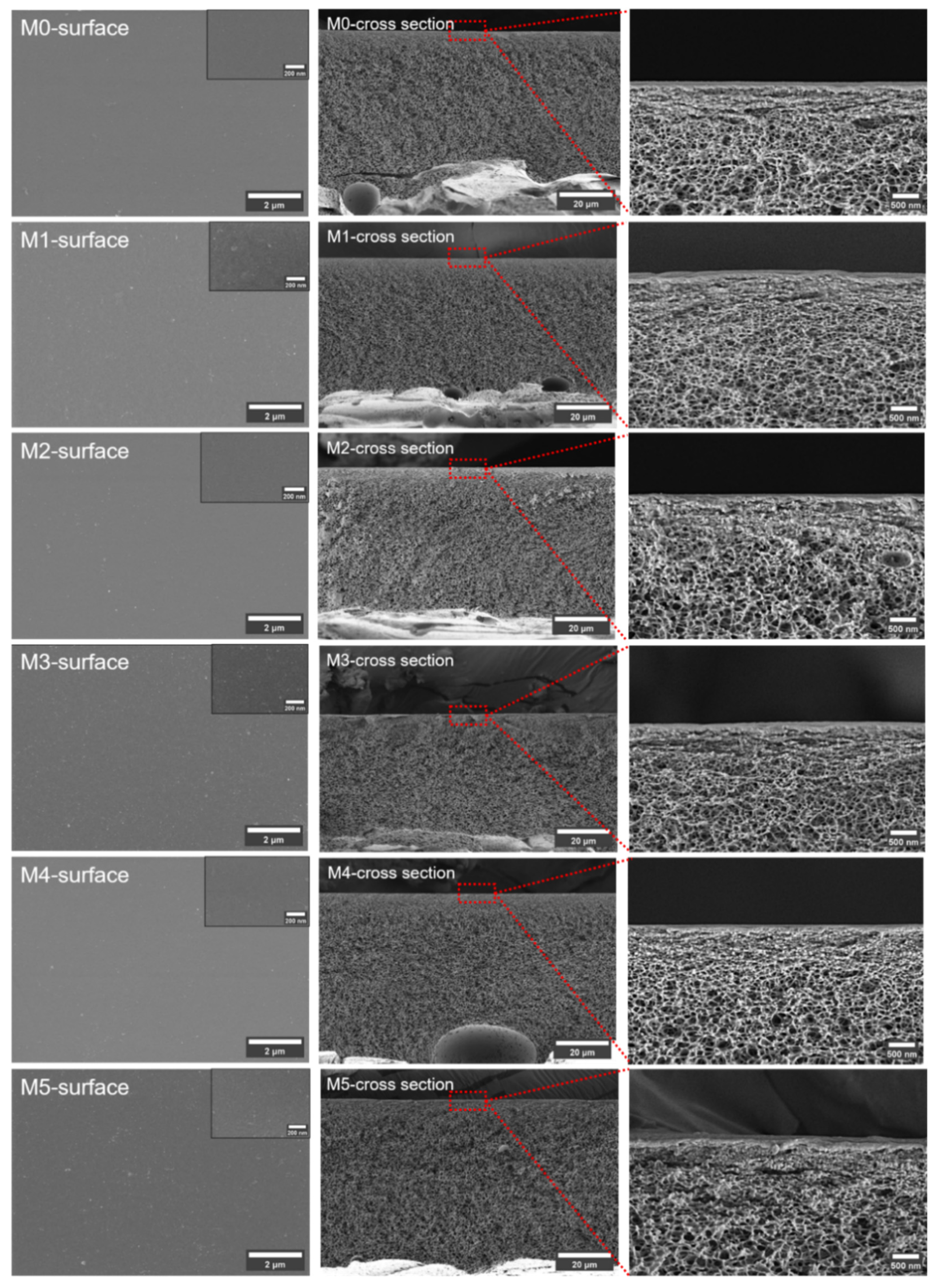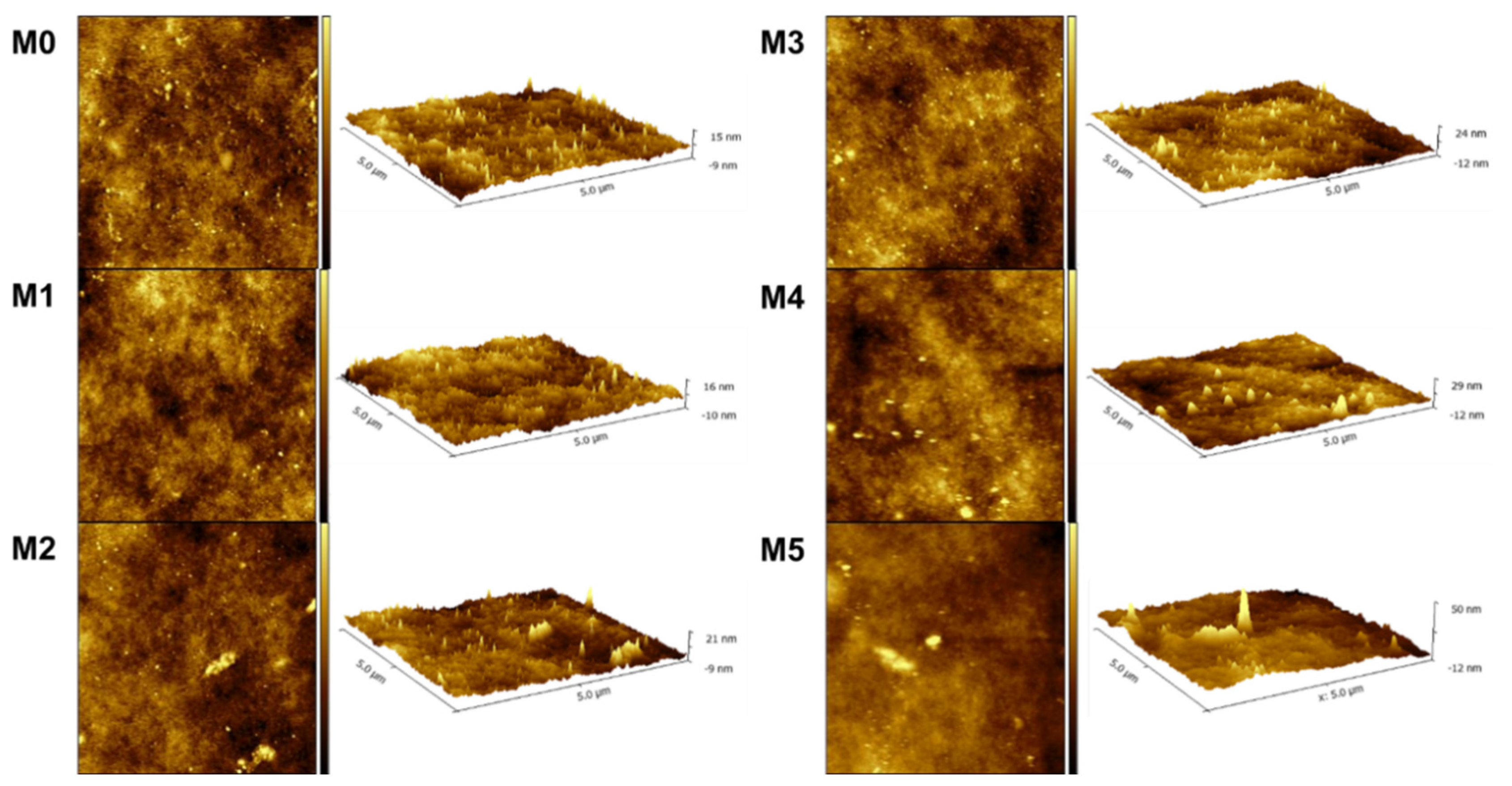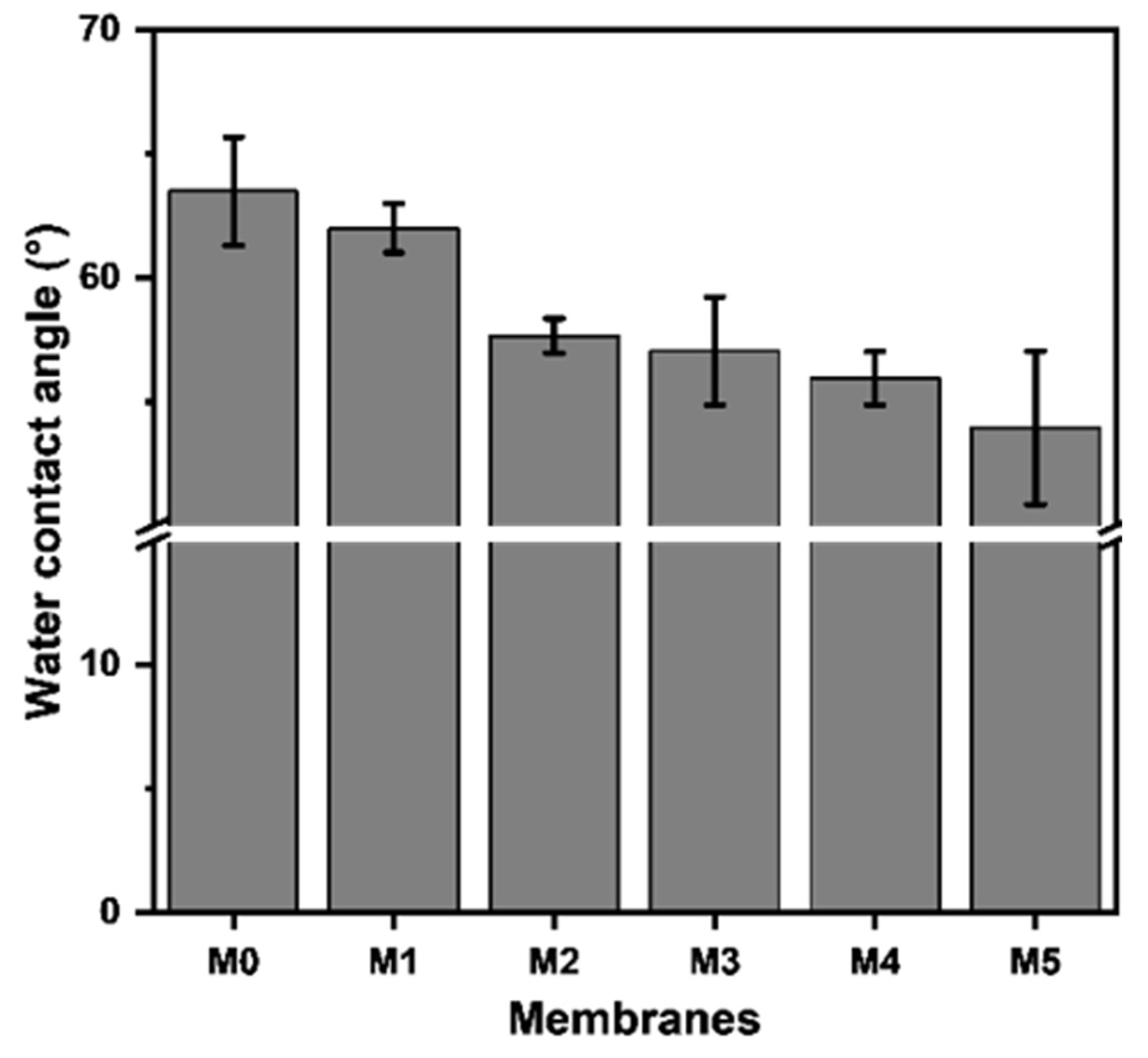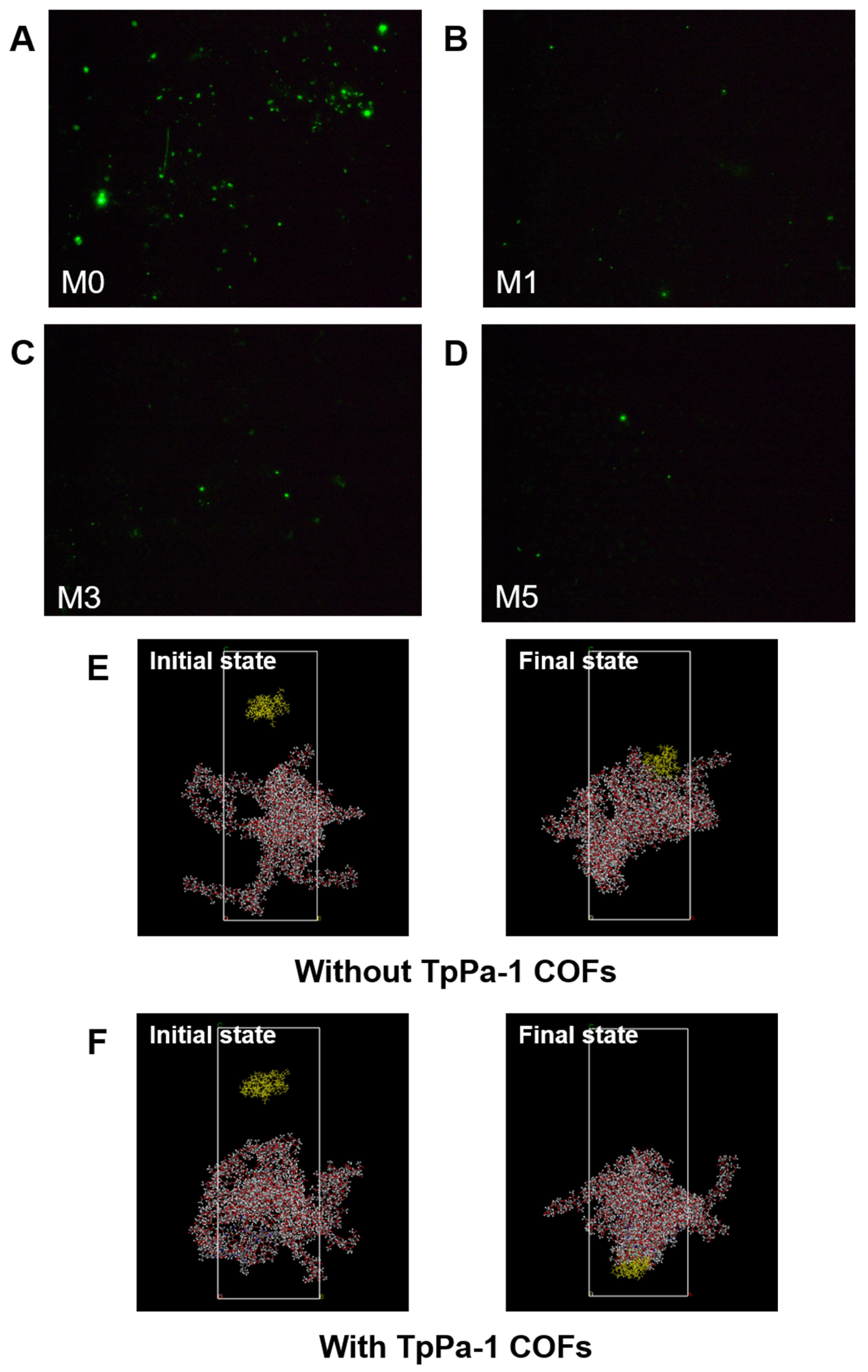Enhanced Protein Separation Performance of Cellulose Acetate Membranes Modified with Covalent Organic Frameworks
Abstract
1. Introduction
2. Materials and Methods
2.1. Materials and Chemicals
2.2. Synthesis of TpPa-1 COFs
2.3. Preparation of Membranes
2.4. Characterization of TpPa-1 COFs
2.5. Characterization of Membranes
2.6. Filtration Tests of Membranes
2.7. Protein Adsorption Experiment
3. Results and Discussion
3.1. Characterization of TpPa-1 COFs
3.2. Characterization of TpPa-1 COF/CA Membranes
3.3. Separation Performance of Membranes
3.4. Characterization of Protein Adsorption of Membranes
4. Conclusions
Author Contributions
Funding
Institutional Review Board Statement
Data Availability Statement
Conflicts of Interest
References
- Ulbricht, M. Advanced functional polymer membranes. Polymer 2006, 47, 2217–2262. [Google Scholar] [CrossRef]
- Madaeni, S.S. The application of membrane technology for water disinfection. Water Res. 1999, 33, 301–308. [Google Scholar] [CrossRef]
- Rosberg, R. Ultrafiltration (new technology), a viable cost-saving pretreatment for reverse osmosis and nanofiltration—A new approach to reduce costs. Desalination 1997, 110, 107–113. [Google Scholar] [CrossRef]
- Liu, Y.; Wang, G. Membranes: Technology and Applications. In Nanostructured Polymer Membranes; Wiley: Hoboken, NJ, USA, 2016; pp. 27–88. [Google Scholar]
- Liu, Y.; Huang, H.T.; Huo, P.F.; Gu, J.Y. Exploration of zwitterionic cellulose acetate antifouling ultrafiltration membrane for bovine serum albumin (BSA) separation. Carbohyd. Polym. 2017, 165, 266–275. [Google Scholar] [CrossRef]
- Mehta, A.; Zydney, A.L. Permeability and selectivity analysis for ultrafiltration membranes. J. Membr. Sci. 2005, 249, 245–249. [Google Scholar] [CrossRef]
- Opong, W.S.; Zydney, A.L. Diffusive and Convective Protein-Transport through Asymmetric Membranes. Aiche J. 1991, 37, 1497–1510. [Google Scholar] [CrossRef]
- Susanto, H.; Ulbricht, M. Characteristics, performance and stability of polyethersulfone ultrafiltration membranes prepared by phase separation method using different macromolecular additives. J. Membr. Sci. 2009, 327, 125–135. [Google Scholar] [CrossRef]
- Zhu, J.Y.; Hou, J.W.; Uliana, A.; Zhang, Y.T.; Tian, M.M.; van der Bruggen, B. The rapid emergence of two-dimensional nanomaterials for high-performance separation membranes. J. Mater. Chem. 2018, 6, 3773–3792. [Google Scholar] [CrossRef]
- Dass, L.A.; Alhoshan, M.; Alam, J.; Muthumareeswaran, M.R.; Figoli, A.; Shukla, A.K. Separation of proteins and antifouling properties of polyphenylsulfone based mixed matrix hollow fiber membranes. Sep. Purif. Technol. 2017, 174, 529–543. [Google Scholar] [CrossRef]
- Yao, A.R.; Yan, Y.Q.; Tan, L.; Shi, Y.D.; Zhou, M.; Zhang, Y.; Zhu, P.X.; Huang, S.J. Improvement of filtration and antifouling performance of cellulose acetate membrane reinforced by dopamine modified cellulose nanocrystals. J. Membr. Sci. 2021, 637, 119621. [Google Scholar] [CrossRef]
- Hong, J.M.; He, Y. Polyvinylidene fluoride ultrafiltration membrane blended with nano-ZnO particle for photo-catalysis self-cleaning. Desalination 2014, 332, 67–75. [Google Scholar] [CrossRef]
- Machado, T.F.; Serra, M.E.S.; Murtinho, D.; Valente, A.J.M.; Naushad, M. Covalent organic frameworks: Synthesis, properties and applications-an overview. Polymers 2021, 13, 970. [Google Scholar] [CrossRef]
- Martín-Illán, J.A.; Rodríguez-San-Miguel, D.; Zamora, F. Evolution of covalent organic frameworks: From design to real-world applications. Coordin. Chem. Rev. 2023, 495, 215342. [Google Scholar] [CrossRef]
- Côté, A.P.; Benin, A.I.; Ockwig, N.W.; O’Keeffe, M.; Matzger, A.J.; Yaghi, O.M. Porous, crystalline, covalent organic frameworks. Science 2005, 310, 1166–1170. [Google Scholar] [CrossRef]
- Feng, X.; Ding, X.S.; Jiang, D.L. Covalent organic frameworks. Chem. Soc. Rev. 2012, 41, 6010–6022. [Google Scholar] [CrossRef]
- Ding, S.Y.; Wang, W. Covalent organic frameworks (COFs): From design to applications. Chem. Soc. Rev. 2013, 42, 548–568. [Google Scholar] [CrossRef]
- Geng, K.Y.; He, T.; Liu, R.Y.; Dalapati, S.; Tan, K.T.; Li, Z.P.; Tao, S.S.; Gong, Y.F.; Jiang, Q.H.; Jiang, D.L. Covalent organic frameworks: Design, synthesis, and functions. Chem. Rev. 2020, 120, 8814–8933. [Google Scholar] [CrossRef]
- Jaid, G.M.; Abdulrazak, A.A.; Meskher, H.; Al-Saadi, S.; Alsalhy, Q.F. Metal-organic frameworks (MOFs), covalent organic frameworks (COFs), and hydrogen-bonded organic frameworks (HOFs) in mixed matrix membranes. Mater. Today. Sustain. 2024, 25, 100672. [Google Scholar] [CrossRef]
- Song, Y.P.; Sun, Q.; Aguila, B.; Ma, S.Q. Opportunities of covalent organic frameworks for advanced applications. Adv. Sci. 2019, 6, 1801410. [Google Scholar] [CrossRef]
- Meng, W.Q.; Xue, Q.; Zhu, J.Y.; Zhang, K.S. Exploiting sulfonated covalent organic frameworks to fabricate long-lasting stability and chlorine-resistant thin-film nanocomposite nanofiltration membrane. Npj. Clean. Water. 2024, 7, 23. [Google Scholar] [CrossRef]
- Meng, W.Q.; Zhu, J.Y.; Xue, Q.; Zhang, K.S. Incorporating imine-based covalent organic frameworks nanosheet as an active filler for long-term nanofiltration desalination. J. Membr. Sci. 2023, 683, 121712. [Google Scholar] [CrossRef]
- Zhang, M.M.; Liu, Z.W.; Yin, Z.Y.; Yang, C.; Long, M.Y.; Lyu, B.; You, X.D.; Zhang, R.N.; Wu, H.; Cheng, L.J.; et al. Anionic COF nanosheets construct porous and charged interlayer for the preparation of high-performance desalination membranes. J. Membr. Sci. 2024, 709, 123153. [Google Scholar] [CrossRef]
- Zhao, J.Y.; Wang, S.W.; Pan, F.S.; Zhang, H.; Zhang, S.; Jiang, Z.Y. Leaf-inspired hybrid membrane assembled by covalent organic framework and cellulose nanocrystals for efficient desalination. J. Membr. Sci. 2024, 701, 122760. [Google Scholar] [CrossRef]
- Lin, X.G.; He, Y.S.; Zhang, Y.T.; Yu, W.Y.; Lian, T. Sulfonated covalent organic frameworks (COFs) incorporated cellulose triacetate/cellulose acetate (CTA/CA)-based mixed matrix membranes for forward osmosis. J. Membr. Sci. 2021, 638, 119725. [Google Scholar] [CrossRef]
- Luo, H.; Bai, X.P.; Liu, H.X.; Qiu, X.; Chen, J.Q.; Ji, Y.B. β-Cyclodextrin covalent organic framework modified-cellulose acetate membranes for enantioseparation of chiral drugs. Sep. Purif. Technol. 2022, 285, 120336. [Google Scholar] [CrossRef]
- Duong, P.H.H.; Kuehl, V.A.; Mastorovich, B.; Hoberg, J.O.; Parkinson, B.A.; Li-Oakey, K.D. Carboxyl-functionalized covalent organic framework as a two-dimensional nanofiller for mixed-matrix ultrafiltration membranes. J. Membr. Sci. 2019, 574, 338–348. [Google Scholar] [CrossRef]
- Ma, Y.F.; Yuan, F.; Yu, Y.; Zhou, Y.L.; Zhang, X.X. Synthesis of a pH-responsive functional covalent organic framework via facile and rapid one-step postsynthetic modification and its application in highly efficient N1-methyladenosine extraction. Anal. Chem. 2020, 92, 1424–1430. [Google Scholar] [CrossRef]
- Chandra, S.; Kandambeth, S.; Biswal, B.P.; Lukose, B.; Kunjir, S.M.; Chaudhary, M.; Babarao, R.; Heine, T.; Banerjee, R. Chemically Stable Multilayered Covalent Organic Nanosheets from Covalent Organic Frameworks via Mechanical Delamination. J. Am. Chem. Soc. 2013, 135, 17853–17861. [Google Scholar] [CrossRef]
- Kandambeth, S.; Mallick, A.; Lukose, B.; Mane, M.V.; Heine, T.; Banerjee, R. Construction of Crystalline 2D Covalent Organic Frameworks with Remarkable Chemical (Acid/Base) Stability via a Combined Reversible and Irreversible Route. J. Am. Chem. Soc. 2012, 134, 19524–19527. [Google Scholar] [CrossRef]
- Shende, P.; Kasture, P.; Gaud, R.S. Nanoflowers: The future trend of nanotechnology for multi-applications. Artif. Cell Nanomed. B 2018, 46, S413–S422. [Google Scholar] [CrossRef]
- Lee, S.W.; Cheon, S.A.; Kim, M.I.; Park, T.J. Organic-inorganic hybrid nanoflowers: Types, characteristics, and future prospects. J Nanobiotechnol 2015, 13, 54. [Google Scholar] [CrossRef] [PubMed]
- Lin, J.K.; Fu, C.L.; Zeng, W.C.; Wang, D.; Huang, F.; Lin, S.; Cao, S.L.; Chen, L.H.; Ni, Y.H.; Huang, L.L. Regulating the structure of cellulose-based ultrafiltration membrane to improve its performance for water purification. Ind. Crop. Prod. 2023, 192, 116082. [Google Scholar] [CrossRef]
- Liu, Y.W.; Ahmed, S.; Sameen, D.E.; Wang, Y.; Lu, R.; Dai, J.W.; Li, S.Q.; Qin, W. A review of cellulose and its derivatives in biopolymer-based for food packaging application. Trends. Food Sci. Technol. 2021, 112, 532–546. [Google Scholar] [CrossRef]
- Vatanpour, V.; Pasaoglu, M.E.; Barzegar, H.; Teber, O.O.; Kaya, R.; Bastug, M.; Khataee, A.; Koyuncu, I. Cellulose acetate in fabrication of polymeric membranes: A review. Chemosphere 2022, 295, 133914. [Google Scholar] [CrossRef]
- Islam, M.D.; Uddin, F.J.; Rashid, T.U.; Shahruzzaman, M. Cellulose acetate-based membrane for wastewater treatment-A state-of-the-art review. Mater. Adv. 2023, 4, 4054–4102. [Google Scholar] [CrossRef]
- Li, W.R.; Wang, Q.; Cui, F.Z.; Jiang, G.F. Covalent organic framework with sulfonic acid functional groups for visible light-driven CO2 reduction. RSC Adv. 2022, 12, 17984–17989. [Google Scholar] [CrossRef]
- Arkhangelsky, E.; Duek, A.; Gitis, V. Maximal pore size in UF membranes. J. Membr. Sci. 2012, 394, 89–97. [Google Scholar] [CrossRef]
- Singh, S.; Khulbe, K.C.; Matsuura, T.; Ramamurthy, P. Membrane characterization by solute transport and atomic force microscopy. J. Membr. Sci. 1998, 142, 111–127. [Google Scholar] [CrossRef]
- Akkermans, R.L.C.; Spenley, N.A.; Robertson, S.H. COMPASS III: Automated fitting workflows and extension to ionic liquids. Mol. Simulat. 2021, 47, 540–551. [Google Scholar] [CrossRef]
- Toumi, K.H.; Bergaoui, M.; Khalfaoui, M.; Benguerba, Y.; Erto, A.; Dotto, G.L.; Amrane, A.; Nacef, S.; Ernst, B. Computational study of acid blue 80 dye adsorption on low cost agricultural Algerian olive cake waste: Statistical mechanics and molecular dynamic simulations. J. Mol. Liq. 2018, 271, 40–50. [Google Scholar] [CrossRef]
- Knani, D.; Barkay-Olami, H.; Alperstein, D.; Zilberman, M. Simulation of novel soy protein-based systems for tissue regeneration applications. Polym. Adv. Technol. 2017, 28, 496–505. [Google Scholar] [CrossRef]
- Salahshoori, I.; Montazeri, N.; Yazdanbakhsh, A.; Golriz, M.; Farhadniya, R.; Khonakdar, H.A. Insights into the Adsorption Properties of Mixed Matrix Membranes (Pebax 1657-g-Chitosan-PVDF-Bovine Serum Albumin@ZIF-CO3-1) for the Antiviral COVID-19 Treatment Drugs Remdesivir and Nirmatrelvir: An In Silico Study. ACS Appl. Mater. Interfaces 2023, 15, 31185–31205. [Google Scholar] [CrossRef] [PubMed]
- Matsuba, R.; Kubota, H.; Matubayasi, N. All-atom molecular simulation study of cellulose acetate: Amorphous structure and the dissolution of small molecule. Cellulose 2022, 29, 5463–5478. [Google Scholar] [CrossRef]
- Wu, X.; Hao, P.; He, F.; Yao, Z.; Zhang, X. Molecular dynamics simulations of BSA absorptions on pure and formate-contaminated rutile (110) surface. Appl. Surf. Sci. 2020, 533, 147574. [Google Scholar] [CrossRef]
- Zhang, Y.F.; Fang, T.M.; Hou, Q.G.; Li, Z.; Yan, Y.G. Water desalination of a new three-dimensional covalent organic framework: A molecular dynamics simulation study. Phys. Chem. Chem. Phys. 2020, 22, 16978–16984. [Google Scholar] [CrossRef]
- Wong, P.C.Y.; Kwon, Y.N.; Criddle, C.S. Use of atomic force microscopy and fractal geometry to characterize the roughness of nano-, micro-, and ultrafiltration membranes. J. Membr. Sci. 2009, 340, 117–132. [Google Scholar] [CrossRef]
- Xu, Y.C.; Zhang, W.T.; Li, Z.W.; Shen, L.G.; Li, R.J.; Zhang, M.J.; Jiao, Y.; Lin, H.J.; Tang, C.Y.Y. Enhanced water permeability in nanofiltration membranes using 3D accordion-like MXene particles with random orientation of 2D nanochannels. J. Mater. Chem. 2022, 10, 16430–16438. [Google Scholar] [CrossRef]
- Yang, G.H.; Zhang, Z.; Yin, C.C.; Shi, X.S.; Wang, Y. Boosting the permeation of ultrafiltration membranes by covalent organic frameworks nanofillers: Nanofibers doing better than nanoparticles. J. Membr. Sci. 2022, 661, 120944. [Google Scholar] [CrossRef]
- Fane, A.G.; Tang, C.Y.; Wang, R. 4.11—Membrane Technology for Water: Microfiltration, Ultrafiltration, Nanofiltration, and Reverse Osmosis. In Treatise on Water Science; Wilderer, P., Ed.; Elsevier: Oxford, UK, 2011; pp. 301–335. [Google Scholar]
- Wang, Q.; Zhang, S.Y.; Dai, F.N.; Yan, X.Y.; Qian, G.T.; Chen, C.H.; Yu, Y.H. Enhanced antifouling property of poly(aryl ether nitrile) ultrafiltration membranes via copolymerization with phenolphthalin. J. Environ. Chem. Eng. 2021, 9, 106132. [Google Scholar] [CrossRef]
- Huang, H.T.; Yu, J.Y.; Guo, H.X.; Shen, Y.B.; Yang, F.; Wang, H.; Liu, R.; Liu, Y. Improved antifouling performance of ultrafiltration membrane via preparing novel zwitterionic polyimide. Appl. Surf. Sci. 2018, 427, 38–47. [Google Scholar] [CrossRef]
- Kumar, R.; Ismail, A.F. Fouling control on microfiltration/ultrafiltration membranes: Effects of morphology, hydrophilicity, and charge. J. Appl. Polym. Sci. 2015, 132, 10974628. [Google Scholar] [CrossRef]
- Chen, S.F.; Li, L.Y.; Zhao, C.; Zheng, J. Surface hydration: Principles and applications toward low-fouling/nonfouling biomaterials. Polymer 2010, 51, 5283–5293. [Google Scholar] [CrossRef]
- Tiwari, S.; Gogoi, A.; Reddy, K.A. Effect of an ionic environment on membrane fouling: A molecular dynamics study. Phys. Chem. Chem. Phys. 2021, 23, 5001–5011. [Google Scholar] [CrossRef] [PubMed]
- Lv, J.L.; Zhang, G.Q.; Zhang, H.M.; Yang, F.L. Exploration of permeability and antifouling performance on modified cellulose acetate ultrafiltration membrane with cellulose nanocrystals. Carbohyd. Polym. 2017, 174, 190–199. [Google Scholar] [CrossRef]
- Zhou, Y.; Jiang, Y.Z.; Zhang, Y.; Tan, L. Improvement of antibacterial and antifouling properties of a cellulose acetate membrane by surface grafting quaternary ammonium salt. ACS Appl. Mater. Interfaces 2022, 14, 38358–38369. [Google Scholar] [CrossRef]
- Ma, X.; Wang, C.Y.; Guo, H.X.; Wang, Z.F.; Sun, N.; Huo, P.F.; Gu, J.Y.; Liu, Y. Novel dopamine-modified cellulose acetate ultrafiltration membranes with improved separation and antifouling performances. J. Mater. Sci. 2022, 57, 6474–6486. [Google Scholar] [CrossRef]
- Guo, H.X.; Peng, Y.; Liu, Y.; Wang, Z.F.; Hu, J.W.; Liu, J.H.; Ding, Q.; Gu, J.Y. Development and investigation of novel antifouling cellulose acetate ultrafiltration membrane based on dopamine modification. Int. J. Biol. Macromol. 2020, 160, 652–659. [Google Scholar] [CrossRef]
- Chiang, Y.C.; Chang, Y.; Higuchi, A.; Chen, W.Y.; Ruaan, R.C. Sulfobetaine-grafted poly(vinylidene fluoride) ultrafiltration membranes exhibit excellent antifouling property. J. Membr. Sci. 2009, 339, 151–159. [Google Scholar] [CrossRef]
- Feng, Q.; Shen, X.; He, Y.; Zhao, Y.; Yan, F.; Chen, L. Effect of Cross-linking on Antifouling Properties for PVDF-g-PACMO Membranes. J. Mater. Eng. 2017, 45, 34–40. [Google Scholar]









| No. | CA (wt%) | DMAc/Ac (w/w) | TpPa-1 COFs (wt%) |
|---|---|---|---|
| Total (78 wt%) | |||
| M0 | 22 | 11/9 | 0 |
| M1 | 22 | 11/9 | 0.000075 |
| M2 | 22 | 11/9 | 0.0001 |
| M3 | 22 | 11/9 | 0.00015 |
| M4 | 22 | 11/9 | 0.0002 |
| M5 | 22 | 11/9 | 0.00025 |
| No. | Ra (nm) | Rq (nm) | WCA (°) |
| M0 | 1.95 ± 0.19 | 2.59 ± 0.27 | 63.50 ± 2.19 |
| M1 | 2.08 ± 0.13 | 2.68 ± 0.17 | 62.02 ± 0.99 |
| M2 | 2.17 ± 0.25 | 2.76 ± 0.25 | 57.68 ± 0.70 |
| M3 | 2.24 ± 0.12 | 2.92 ± 0.04 | 57.06 ± 2.18 |
| M4 | 2.55 ± 0.45 | 3.21 ± 0.42 | 55.96 ± 1.08 |
| M5 | 2.66 ± 0.43 | 3.51 ± 0.52 | 53.96 ± 3.09 |
| Polymer | Modification Method | Material | Permeance (L·m−2·h−1·bar−1) | BSA Rejection (%) | BSA Adsorption Amount (μg/cm2) | Ref. |
|---|---|---|---|---|---|---|
| zwitterionic CA | novel material | / | 137.98 | 93.6 | 23.6 | [5] |
| CA | mix | PDA@CNCs | 320 | 12.4–15 | 0.52 | [11] |
| PEN-COOH-60% | novel material | / | 351.7 | 99.3 | 56.8 | [51] |
| R-PI | / | / | 88.32 | 96.3 | 112.7 | [52] |
| Z-PI | novel material | / | 127.65 | 93.4 | 43.8 | [52] |
| CA | mix | CNCs | ~40 | 92.55 | 7.194 | [56] |
| CA | surface grafting | EPDMDAC | 308 | 38.1 | 0.45 | [57] |
| CA-2,3-DA | novel material | / | 167.3 | 92.5 | 21.5 | [58] |
| CA-DA | novel material | / | 181.2 | 93.5 | 20.3 | [59] |
| PVDF | surface grafting | zwitterion | ~80 | ~70 | ~2.0 | [60] |
| PVDF | mix | polyaniline | ~100 | ~92 | 30 | [61] |
| PVDF | mix | sulfonated polyaniline | ~160 | ~90 | 3 | [61] |
| CA (M3) | mix | TpPa-1 COFs | 17.11 | 97.34 | 4.64 | This work |
Disclaimer/Publisher’s Note: The statements, opinions and data contained in all publications are solely those of the individual author(s) and contributor(s) and not of MDPI and/or the editor(s). MDPI and/or the editor(s) disclaim responsibility for any injury to people or property resulting from any ideas, methods, instructions or products referred to in the content. |
© 2025 by the authors. Licensee MDPI, Basel, Switzerland. This article is an open access article distributed under the terms and conditions of the Creative Commons Attribution (CC BY) license (https://creativecommons.org/licenses/by/4.0/).
Share and Cite
Shao, S.; Liu, M.; Tao, B.; Lasisi, K.H.; Meng, W.; Wu, X.; Zhang, K. Enhanced Protein Separation Performance of Cellulose Acetate Membranes Modified with Covalent Organic Frameworks. Membranes 2025, 15, 84. https://doi.org/10.3390/membranes15030084
Shao S, Liu M, Tao B, Lasisi KH, Meng W, Wu X, Zhang K. Enhanced Protein Separation Performance of Cellulose Acetate Membranes Modified with Covalent Organic Frameworks. Membranes. 2025; 15(3):84. https://doi.org/10.3390/membranes15030084
Chicago/Turabian StyleShao, Shurui, Maoyu Liu, Baifu Tao, Kayode Hassan Lasisi, Wenqiao Meng, Xing Wu, and Kaisong Zhang. 2025. "Enhanced Protein Separation Performance of Cellulose Acetate Membranes Modified with Covalent Organic Frameworks" Membranes 15, no. 3: 84. https://doi.org/10.3390/membranes15030084
APA StyleShao, S., Liu, M., Tao, B., Lasisi, K. H., Meng, W., Wu, X., & Zhang, K. (2025). Enhanced Protein Separation Performance of Cellulose Acetate Membranes Modified with Covalent Organic Frameworks. Membranes, 15(3), 84. https://doi.org/10.3390/membranes15030084








